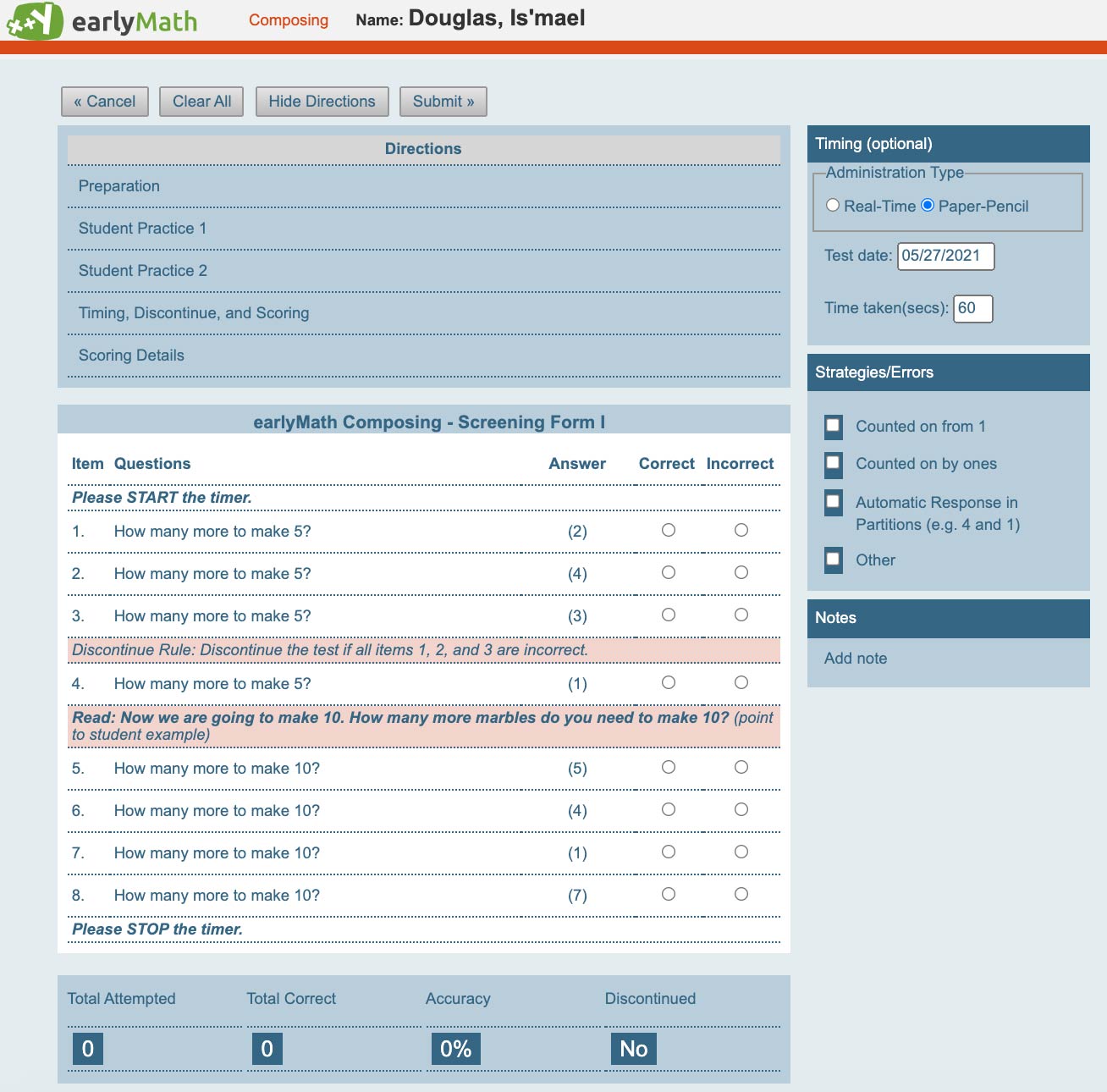earlyMath
earlyMath measures developing math skills and is typically used in kindergarten and first grade. Items for PreK are in Lab Status.
earlyMath was developed using the most cutting-edge research literature and professional consultation in test development and mathematics education. Each of the subtests is aligned with National Common Core State Standards (CCSS, 2010) and three domains of number sense: number, relations, and operations (Purpura & Lonigan, 2013; National Research Council, 2009).

The Subtests
The earlyMath assessment includes a total of 17 total subtests covering 13 concepts (some concepts have two subtests: one for grade K and one for grade 1). However, not all of them are used at the same time. Some of the subtests are used only for screening and others for progress monitoring.
| Concept | Skills Measured |
|---|---|
| Numeral Identification | Recognizing numerals |
| Subitizing | Immediate recognition of quantities |
| Match Quantity | Matching a numeral with the quantity it represents |
| Quantity Discrimination (Most & Least) | Identifying the largest and smallest number in a set |
| Number Sequence | Providing the correct oral sequence of numbers |
| Decomposing | Identifying the missing whole in a part-part-whole problem |
| Decomposing | Identifying a missing part in a part-part-whole problem |
| Counting Objects | Counting with one-to-one correspondence and cardinality |
| Equal Partitioning | Identifying equal and unequal sets |
| Verbal Addition | Providing the answer to an addition problem (without paper and pencil) |
| Verbal Subtraction | Providing an answer to subtraction problem (without paper and pencil) |
| Story Problems | Solving verbally presented word problems |
| Place Value | Identifying the place values and amounts of pictured objects |
FastBridge preselects which subtests to use based on time of year and then a composite score is calculated once all three are completed. The remaining assessments may be used as needed to further evaluate skill deficits. Results help identify student risk while informing instruction.
earlyMath is the grade K-1 assessment companion to CBMmath (grades 2-12).
Screening
All the earlyMath subtests can be used to screen students up to five times per year. Benchmark standards (i.e., “cut scores” or “targets”) are built into the system to identify risk and provide indicators of a student’s likelihood of meeting a later learning goal. The best estimate of student early mathematics skill is the earlyMath composite score, comprised of subtest scores from multiple tests administered during a universal screening period. These composite scores were developed to be optimal predictors of spring broad math achievement in kindergarten and first grade.
Reports provide profiles of students’ strengths and areas of difficulty relating to mathematical concepts and can provide useful information to plan instruction.
Progress Monitoring
earlyMath is uniquely designed to accommodate quick, easy, and flexible progress monitoring on a frequent basis. Progress monitoring data help teachers evaluate instructional impact and determine if differentiated instruction or interventions are effective. FastBridge preselects which subtests are available for teachers to use for progress monitoring as part of FASTtrack Math. Subtets include: numeral identification, counting, cardinality, part-whole relationships.
Administration
earlyMath assessments are individually administered. The proctor marks student responses electronically as the student completes the brief assessment. Paper-and-pencil versions are also available. Student scores are reported instantly and stored in the database for longitudinal analysis.
What Is Lab Status?
In order to reduce the typical 10- to 30-year gap between university research and classroom results, FastBridge releases developing assessments in “Lab Status.” This phase allows educators to preview new tools and provide feedback on functionality. It also allows FastBridge researchers to confirm the psychometric properties of new measures when used in everyday classroom settings. This results in more accurate benchmarks and norms once the measure moves out of Lab Status.
FASTtrack Math
FASTtrack Math provides teachers with easy access to the recommended math screening assessments for each grade level. FASTtrack Math includes two specific assessments that students complete three times a year for universal screening. FastBridge has pre-selected the specific assessments to use based on their capacity to predict future student math performance and indicate what type of math instruction is needed now. After students complete both the specific and general math assessments, the teacher can view the scores and see recommended math instruction plans using the Screening to Intervention (s2i) report.

